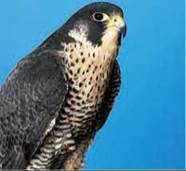CONCEPTS IN BIOLOGY
PART V. THE ORIGIN AND CLASSIFICATION OF LIFE
23. The Animal Kingdom

Peregrine Falcon Back from the Brink of Extinction
Urban birds are part of the story.
The peregrine falcon (Falco peregrinus) is a crow-sized bird with a worldwide distribution. It is a predator on smaller birds such as pigeons, doves, shorebirds, and ducks. Its method of hunting is adapted to open spaces where it can spot prey and pursue it. Typically a peregrine will perch on an elevated site or hover while searching for prey. When it spots prey, it dives at speeds of up to 320 kilometers per hour (200 mph) and strikes its prey in the air.
As with many other predatory birds, the population of peregrine falcons was severely reduced by the accumulation of DDT, an insecticide commonly used from about 1940 to 1972. DDT caused egg shells to be thin, and few offspring were raised successfully. Consequently populations of the American subspecies that nests in Canada, the United States, and Mexico fell from an estimated 3,875 pairs in the 1900s to 324 pairs in 1975. The ban on the use of DDT in 1972 and the passage of the Endangered Species Act in the United States helped to save it. Captive breeding programs were instituted to rebuild the population and, in 1999, the peregrine falcon was removed from the list of endangered species. Today, there are between 2,000 and 3,000 nesting pairs in North America.
One of the interesting sidelights to this successful recovery is that many pairs of birds have adapted to urban settings. Some were purposely released in urban settings but wild birds have also taken up an urban lifestyle. Tall buildings and bridges provide nesting sites similar to their normal nesting sites on cliffs. The areas between buildings provide suitable open space for hunting and the abundant supply of urban birds (particularly pigeons and starlings) provides a ready food source.
• Why is the thickness of the egg shell important?
• Why are birds and mammals more likely than insects to be on endangered species lists?
• DDT is still used in some countries to control mosquitoes that carry malaria. Should it be banned in those countries?
ü Background Check
Concepts you should already know to get the most out of this chapter:
• The processes of natural selection and evolution (chapter 13)
• That structural and life history characteristics are used to classify organisms (chapter 20)
• That cells are specialized to perform certain functions (chapter 4)
23.1. What Is an Animal?
Animals are eukaryotic, multicellular organisms whose cells lack cell walls. Like plants, animals have cells that are specialized for specific purposes. Functions such as ingesting food, exchanging gases, and removing wastes are more complicated in animals than in one-celled protists. In one-celled organisms, any exchange between the organism and the external environment occurs through the plasma membrane. However, because animals are multicellular, most of their cells are not on the body surface and, therefore, not in direct contact with the external environment. Thus, animals must have specialized ways to exchange materials between their internal and external environments.
Some simple animals, such as sponges and jellyfish, have a few kinds of specialized cells, whereas other, more complex animals, such as insects and mollusks, have bodies composed of groups of cells organized into tissues, organs, and organ systems. The more complex animals have gills, lungs, or other structures used to exchange gases; various kinds of structures are involved in capturing and digesting food; and there are usually special structures for getting rid of waste products. Like plants, many of the larger animals have a method of transporting materials throughout the body.
Animals are heterotrophs that eat other organisms to obtain organic molecules, and many are specialized for consuming certain kinds of food organisms. Although there are many ways of capturing and consuming food, all of them involve movement.
Movement is a characteristic associated with all animals; it involves specialized muscle cells that shorten. Many animals have appendages (e.g., legs; wings; tentacles; spines; or soft, muscular organs) that bend or change shape. Often, these structures are involved in moving the animal from place to place, but they are also used to capture food, to clean the animals’ surfaces, and to move things in the animals’ environment.
Sexual reproduction is important in all groups of animals. The methods vary greatly—from the release of sperm and eggs into the water, for many aquatic organisms, to fertilization inside the body, for most terrestrial organisms. A few kinds, such as birds and mammals, provide a great deal of care for their offspring. Asexual reproduction is also an important part of the life cycle of many of the more primitive animals. Those that reproduce asexually also reproduce sexually at other times in their life cycle.
Animals also have sensory structures on their surface that detect changes in the environment. A system of nerve cells integrates information about the environment and coordinates movements, so that movements occur at appropriate times and with a proper orientation. Figure 23.1 shows a variety of animals.

FIGURE 23.1. Variety of Animals
Animals show an amazing variety of body forms and lifestyles.
23.1. CONCEPT REVIEW
1. List three characteristics shared by all animals.